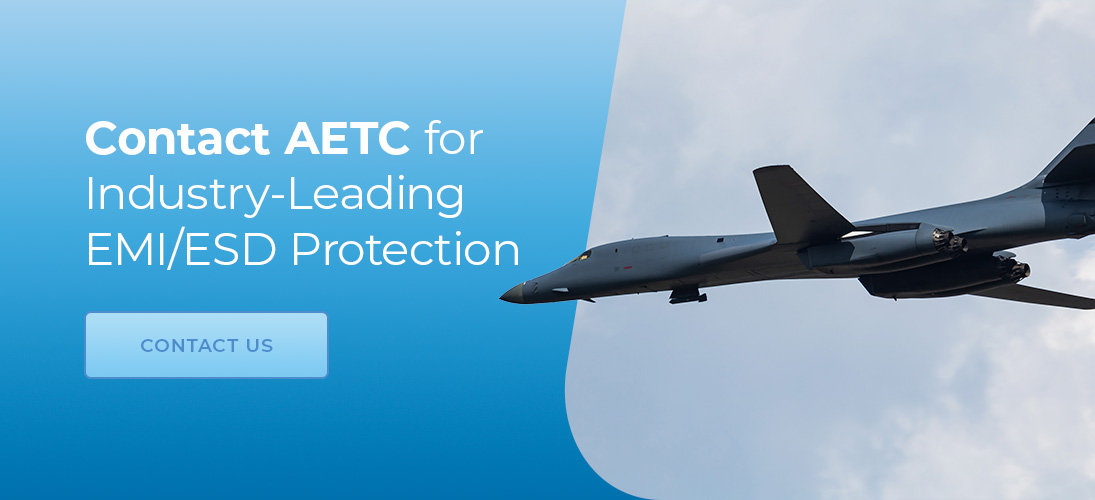Experts believe that electrostatic discharge (ESD) events are behind many failures in the aviation industry, which is full of delicate ESD-sensitive (ESDS) components.
ESDS is a complex problem that requires a multi-layered approach to solve. Although taking the proper precautions to shield your equipment from damage is a strong step in the right direction, equipment manufacturers must continue improving their products to be more resistant to electromagnetic interference (EMI) and ESD.
What Are EMI and ESD?
EMI and ESD are two electrical phenomena that can seriously affect electronic aviation equipment such as cockpit gauges, electronic initiators and more. Understanding what they are and what causes them can help aviators significantly reduce their risk of component failure.
Electromagnetic Interference
EMI is an electrical phenomenon that occurs when electromagnetic signals from multiple sources disrupt the normal operation of electronic devices or systems. For example, a COM radio inside the cockpit of an aircraft might produce static when the vessel passes by a cell tower, which could prevent the pilot from conveying critical information to the control tower.
Prolonged exposure to EMI can cause a noticeable decline in equipment performance and, left unchecked, total malfunctions.
Common sources of EMI disruptions in aircraft include:
- Radio waves
- Laptop computers
- Mobile devices
- Power lines
- Weather events such as lightning or solar flares
- Nearby electronic devices
- Electrostatic discharge
Of all these causes, ESD is especially problematic because it can cause lasting harm to electronic components.
Electrostatic Discharge
ESD is an unintended energy transfer that naturally occurs when there is a difference in potential between two charge-carrying bodies. Touching a doorknob in winter and getting shocked is a common example of ESD, but the discharge voltage must be high for us to feel it. Electronic devices can sustain damage at much lower levels.
An ESDS component is an electronic component that is more likely to experience damage or failure due to an ESD event. Generally, the smaller and faster a component or device is, the higher its sensitivity level.
The Risks of EMI and ESD in Aviation
EMI- and ESD-sensitive components can suffer serious damage when an event occurs, even if the discharge is of a relatively low voltage.
There are four types of damage an ESD or EMI event can cause:
- Parametric failures: ESD can alter component parameters, causing the values given in the product datasheet to shift and result in a minor failure. Parametric failures rarely interfere with component function, though they can impact equipment readings.
- Latent damages: The damage resulting from an ESD event can go unnoticed for long periods of time, as testing typically will not detect latent damage. However, damage can build up over time and impact component performance, eventually leading to total failure.
- Upset failure: Although a minor current flow may not be enough to cause total failure in a component, it can cause intermittent leakage during use. Like latent damage, upset failure is difficult to detect during testing.
- Direct catastrophic failures: The presence of differing electrostatic fields can lead to a catastrophic failure, which damages the equipment to the point that it becomes unusable. Catastrophic failure can occur as a result of building ESD damage over multiple events, or it can happen after one especially severe event.
Prevention is key for protecting sensitive aviation equipment from EMI- and ESD-related damage, so it’s important to understand which devices are most at risk of ESD events.
Which Components Are Most at Risk?
The sensitivity of an electronic component or system depends on several factors, including its material and typical operating conditions. Some common ESDS components include:
- Capacitors: While semiconductor and low-voltage capacitors are highly sensitive to even low-voltage ESD events, the ESD sensitivity of ceramic and electrolytic capacitors increases along with voltage.
- Integrated circuits (ICs): ESD events can cause an IC to overheat, resulting IC burnout, ruptures and interface damage to nearby components.
- Resistors: Although ESD is sometimes used in thick-film resistor manufacturing, exposure to excessive ESD can alter the tolerance value and cause ruptures in the film.
- Metal oxide silicon field effect transistors: ESD sensitivity can cause overheating, insulation breakdown or material migration within the component.
- Light-emitting diodes (LEDs): LED lights are especially ESD-sensitive, though risk varies between specific voltages and models. As a result, most LEDs come with built-in ESD suppressors — however, especially small LEDs often have an external suppressor.
Devices containing these and other ESDS components are at increased risk of ESD-related failure and must be labeled accordingly. The symbol for ESDS components is a triangle with a reaching hand in the center, usually accompanied by warning text.
Training employees to recognize this label and other signs of ESD sensitivity can help you protect your equipment more effectively. Even the most experienced individual can benefit from a refresher course, just to ensure they know how to tackle the task in front of them.
How to Mitigate EMI and ESD
Taking proper precautions and following important industry and safety standards is key for preventing EMI- and ESD-related damage to your aviation systems. Some of the standards you should pay attention to include:
- ANSI/ESD S20.20-2021
- ANSI/ESD S541-2019
- ANSI/ESD S6.1-2019
- ANSI/ESD S8.1-2021
- IEC 61340-5-1
To protect any devices containing ESDS components, it’s important to use items with ESD-safe classification, such as anti-static mats and chairs that conduct electric charges away from electronic devices.
Other techniques for protecting sensitive devices include:
- Shielding: Placing sensitive equipment in shielded containers can help block EMI from external sources. ESD workstations, for example, are shielded areas that direct static away from workers and their tools.
- Personal grounding equipment: Wearable gear like specialized shoes, anti-static wrist straps and disposable heel grounders prevent friction from building and generating a potential discharge.
- Careful handling: Handling electrostatic-sensitive devices with caution is essential for preventing damage. Employees should hold ESDS devices by the edges or frames to avoid coming into contact with exposed circuitry or other highly sensitive areas, and extra caution is critical in cold weather.
- Static control programs: Training employees on how to properly handle, test and transport ESDS items is important for minimizing your risk of equipment failure during normal operations.
Contact AETC for Industry-Leading EMI/ESD Protection
Finding innovative solutions for managing EMI/ESD sensitivity levels is part of our mission at AETC. We’re a Texas-based original equipment manufacturer dedicated to providing our clients with the best, most reliable aircraft pyrotechnic components possible. That commitment includes continuously improving our products to resist ESD and EMI in various settings.
We work with our customers to create solutions that take their unique needs into account. Contact us today to learn more about how AETC is working to provide protection against ESDS and EMI for military, private and commercial aviation applications.








